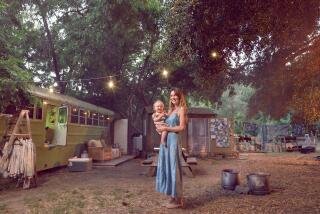Hope Transplant : Cell Procedure Aids 2nd LaRue Boy With Rare Disorder
Bumping along on a Big Wheel tricycle, 4-year-old Garrett LaRue roared out of UCLA Medical Center on Tuesday and pedaled for home, his fragile body cleansed of a rare genetic disorder that probably would have killed him before his 10th birthday.
The Oxnard boy, whose immune system has been wiped out by chemotherapy in the past two months and reborn with a cutting-edge blood cell transplant, was clearly ready to be rid of the hospital--with all of its needles and doctors and tests.
He wanted nothing more than to go home and gobble down a big bowl of his favorite meal: macaroni and cheese.
Garrett may be headed home, but heâs far from home free.
The next few months will be key as doctors carefully monitor Garrettâs progress to see if the blood cells that have been planted in his young body multiply and flourish.
For the boyâs parents, Scott and Theresa LaRue, the waiting is nothing new. Their youngest son, Blayke, successfully underwent the same procedure a year ago to cure the same disorder.
*
âItâs definitely a different feeling than when we left with Blayke,â said Theresa LaRue, holding 20-month-old Blayke in one arm while a mob of camera crews recorded the familyâs departure Tuesday afternoon.
âWhen we left the first time we knew we would still have to come back with Garrett,â she said. âNow weâre feeling like itâs almost finished.â
It has been a long, hard road to the finish. The boys suffer from a disease known as X-linked lymphoproliferative, a genetic disorder that disables the bodyâs immune system.
The condition is so rare that only about 300 cases have been reported worldwide since it was discovered in the late 1960s.
Unfortunately for the LaRues, three of those cases involved their sons. In 1995, before they realized their children were carrying the disease, it killed their 13-month-old son, Layne.
Later that year, the LaRues learned that Blayke and Garrett also had the disease, which only afflicts boys and can only be cured with a blood cell transplant.
It was then that the Oxnard couple launched a desperate drive to save their children, scrambling to find suitable bone-marrow donors. The couple eventually settled on a new procedure--similar to a bone-marrow transplant--in which donated blood, rich with stem cells, is given to the patient.
*
The stem cells, which develop the bodyâs immune system, come from placental blood extracted from an umbilical cord. By early last year, only about 160 transplants using stored blood from umbilical cords had been done worldwide.
Using a donor from a New York blood bank, doctors at UCLA performed the procedure for their first time on Blayke, completely replacing his compromised immune system last February.
That worked so well that the LaRues decided to try it with Garrett. He underwent the transplant on Jan. 13.
âWhen we saw how well Blayke did we wanted Garrett to have the same chance,â Theresa said. âWe were very fortunate to find two matches for our kids.â
Of course, they had plenty of help along the way.
Firefighters at the Alhambra Fire Department, where Scott LaRue is a paramedic, have covered all his shifts for more than a year and raised money for the family. Meanwhile, officers with the Los Angeles Police Department--where the boysâ grandfather, Ron LaRue, is a lieutenant in the North Hollywood Division--helped organize donor drives.
Although donors for both boys were ultimately found outside California, the drives added more than 6,000 names to the national donor bank.
Doctors are hopeful that the transplants will allow both boys to live healthy, normal lives. If Blayke is any indication, there is a good chance of that happening.
*
When he left the hospital, he was weak and bald from a barrage of chemotherapy leading up to the procedure. Now a toddler, Blayke is alert and has a full head of curly, blond hair. He has just learned to walk and had his catheter removed earlier this month, which means no more drugs.
âI think this has helped us deal with the loss of our son,â Scott LaRue said of the potentially lifesaving treatment administered to his two other boys. âThis is the beginning of a lot of stuff for a whole year, but the hardest part is over.â
On Tuesday, Garrett and his older brother, Aaron--Theresaâs child from a previous marriage, who is not affected by the disease--pedaled their Big Wheels around the quad in front of the entrance to the medical center.
Looking at the scene, Theresa LaRue said the most difficult thing about Garrettâs recovery could be trying to slow him down.
âHe has always been a very active child,â she said. âWe were worried about how he was going to do in the hospital. Weâre trying to mellow him out a little bit.â
Dr. Kathleen Sakamoto, a pediatric hematologist with UCLA Childrenâs Hospital, was on hand to bid farewell to the family. She handed the boys UCLA baseball caps as parting gifts. Theresa joked about whether she could bring the boys back in a few years for a free education.
Starting with Blayke, Sakamoto said, promising advances have been made with the blood cell transplant procedure. In addition to the LaRue boys, two children have undergone the treatment at UCLA in the past year.
âThere are many diseases where the cord stem cells can be used,â she said. âYou will definitely see more and more of it, no question about it.â
More to Read
Sign up for Essential California
The most important California stories and recommendations in your inbox every morning.
You may occasionally receive promotional content from the Los Angeles Times.










